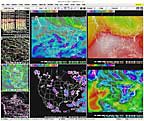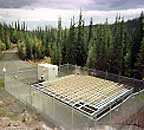Transferring technology from laboratory to operations
What does the Forecast Systems Laboratory do for the nation?
The Forecast Systems Laboratory (FSL) transfers new technology and research findings in atmospheric, oceanic, and hydrologic sciences to other NOAA offices and users of environmental information. FSL anticipates the science and technology that will be needed in the nation's weather and ocean observing operational services in the next five to ten years. More than ever, the rapid pace of technological change dictates the importance of these efforts. To accomplish this, FSL concentrates on four major areas:
- Bringing new atmospheric observing systems to maturity.
- Developing and improving regional mesoscale models for detailed weather predictions.
- Investigating parallel computer architectures as a vehicle for handling the huge computational demands of environmental models.
- Developing environmental information systems for a variety of customers, both within and outside NOAA.
Recent Accomplishments:
- Through the NOAA Profiler Network (NPN) and other networks, FSL continues to gather atmospheric observations from disparate sources in the service of local forecasting and regional modeling. For example, the number of Cooperative Agency Profilers, most of which sample the boundary layer, has grown to over 60. The number of ground-based GPS sites estimating total column water vapor now exceeds 200. More than 5,000 new surface mesonet observations have been added to the FSL hourly collection. These data are quality controlled at FSL and then forwarded to the National Centers for Environmental Prediction (NCEP) for use in operational models. Payoffs: These data all figure in the design of the future operational mesoscale observing system over the U.S. Very high-resolution observing and new-generation models can greatly improve short-range forecasts of high impact weather, in particular, severe convective storms, heavy snow/ice storms, and hazardous weather for surface and air travel.
- FSL's major research interests center around short-range numerical weather prediction (NWP), development of advanced modeling and data assimilation techniques, diagnostic studies of mesoscale weather phenomena, and applications of NWP to daily commerce. Recent accomplishments in modeling include 3D variational analysis, now operational in the 20-km Rapid Update Cycle. This opens the door to assimilation of many new sources of observations that were previously difficult to accommodate. A multiagency Developmental Test Center is being established in Boulder to initially focus on the development of the Weather Research and Forecasting (WRF) model, designed as both an operational model and a research vehicle for the larger modeling community. Payoffs: Frequent high-resolution analyses and forecasts produced in real time are valuable to commercial aviation, civilian/military weather forecasting, energy industry, regional air pollution prediction, and emergency preparedness. The WRF model will greatly increase the accuracy and specificity of weather forecasts.
- A new project at FSL, Science On a SphereTM, responds to NOAA's goals to educate present and future generations about the changing Earth and its processes. It presents NOAA's global science in an exciting way through a 3D representation of our planet as if the viewer were looking at the Earth from outer space. It has received major exposure with hundreds of students and parents, the NOAA Science Center, and meetings of the American Meteorological Society and the National Cable and Telecommunication Association. Payoffs: Science On a SphereTM is a powerful, revolutionary system for educating the public on the holistic nature of Earth's oceans, atmosphere, biology, and land.
- As a leader in high-performance computing, FSL provides essential infrastructure for weather and other environmental research. Its high-performance computing system comprises 768 nodes with dual Intel Pentium processors rated at 2.2 Ghz. An upgrade in November 2002 ranked it #8 on the Top 500 List of the World's Fastest Computers. Payoffs: Supercomputers are necessary in the development of very high-resolution mesoscale models that serve both the research and operational communities, leading to advances in atmospheric and oceanic forecasting capabilities, and for testing future observing systems through repeated model simulations that require extraordinary processing power.
- FSL continues its important role in developing systems related to the Advanced Weather Interactive Processing System (AWIPS), an interactive computer system that integrates all meteorological, hydrological, satellite, and radar data. Capitalizing on major development work at FSL, the National Weather Service is installing two Linux-based workstations at each Weather Forecast Office in the U.S. to replace outdated hardware that inaugurated the AWIPS era. FSL also developed the FX-Net workstation as a low-cost alternative to AWIPS workstations. Using Wavelet compression techniques developed at FSL, FX-Net can deliver fairly large datasets, and is the workstation of choice at the National Interagency Fire Center in Boise, and at 11 Geographic Area Coordination Centers in the U.S. Meteorologists used FX-Net last summer to fight Colorado wildfires during an unprecedented drought. Payoffs: More timely and accurate warnings and forecasts require continued improvements to AWIPS and development of new subsystems.
What’s next for FSL?
During the next five to ten years, FSL will continue to play a lead role in supporting NOAA in the following areas:
- Apply technology and research to the design, demonstration, and evolution of environment-related systems that are effective in real-time, highly demanding operational environments.
- Conceive, design, test, and use meteorological observing systems, with an emphasis on integrated observing systems employing a large range of sensors and measuring systems. These efforts will significantly contribute to the observing system of the 21st Century.
- Develop modeling and assimilation techniques to improve nowcasting, severe weather watches and warnings, quantitative precipitation forecasts, water management, monitoring air quality, fire weather, regional climate simulations, and design of observing systems, with emphasis on the WRF model.
- Support NOAA in high-performance computing through 1) investigation of new computing technologies and proving their utility, 2) scalable model tool development, and 3) improved infrastructure.
- Anticipate and respond to customers' needs in an ever-changing technological world, through new program development, collaborations, and enhanced environmental science education.
Research Partnerships
FSL collaborates with two of NOAA's Joint Institutes: the Cooperative Institute for Research in Environmental Sciences (CIRES) at CU-Boulder, to provide collaborative research and teaching in many disciplines of the environmental sciences; and the Cooperative Institute for Research in the Atmosphere (CIRA) at CSU, to increase atmospheric research in areas of mutual interest in academia, government, and industry. FSL is supported by one Commercial Service Affiliate, the Systems Research Group, Inc. in Colorado Springs.
Budget and Staff
The FY 2003 enacted budget for the FSL budget lines totaled $10.7M, and its request for FY 2004 totaled $7.4M. The decrease in the FY 2004 request is due to the proposed termination of the NOAA Profiler Network (-$4.2M). FSL employs 219 people: 90 federal, 56 Joint Institutes (39 CIRA and 17 CIRES), 57 Commercial Affiliates, and 16 Visiting Scientists.




 For
more information, contact:
For
more information, contact: